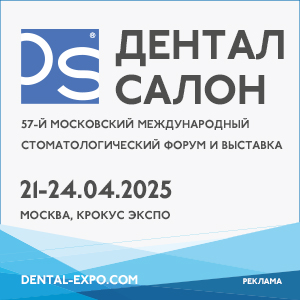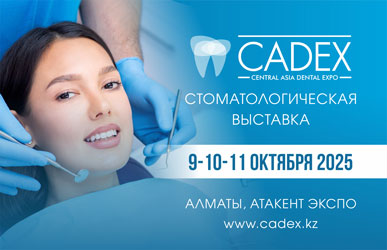DOI:
10.37988/1811-153X_2024_2_130Сравнительный анализ биодеградации и биосовместимости коллагеновых материалов на основе дермального коллагена при подслизистой имплантации в полости рта лабораторных животных
Загрузки
Аннотация
Цель работы — анализ эффективности, биодеградации и биосовместимости стоматологического материала Matriflex (Биофармахолдинг, Россия) в различных вариантах исполнения (Fibro, Direct и Correct) в сравнении с широко используемым в клинической практике импортным материалом Mucoderm (Botiss biomaterials, Германия) при подслизистой имплантации в полости рта кроликов в области оперативного доступа.Материалы и методы. Шести животным в области верхней челюсти интраоперационно создавали 4 кармана, в которые помещали исследуемые мембраны. Животных выводили из эксперимента на 14-е и 90-е сутки после операции. В области имплантации стоматологическим микрометром измеряли толщину мягких тканей до оперативного вмешательства, а также на 14-е и 90-е сутки после операции. Для оценки биодеградации и биосовместимости проводили гистологическое исследование тканей из областей имплантации. Оценку тканей на гистологических препаратах проводили методом стандартной оптической микроскопии, выполняли полуколичественный анализ признаков воспаления и регенерации.
Результаты. Все материалы вызывали увеличение объема мягких тканей в области их имплантации. Выраженность аугментации при имплантации Fibro и Direct была постоянной как на 14-е, так и на 90-е сутки. В то же время Correct и Mucoderm характеризовались положительной динамикой увеличения объема мягких тканей на 14-е и 90-е сутки при сходных величинах измеряемого показателя. По данным гистологического исследования, все мембраны подверглись существенной или полной биодеградации к 90-м суткам после операции. Биодеградация сопровождалась формированием в областях имплантации аутологичной новообразованной соединительной ткани. На 14-е сутки выявлена бо´льшая интенсивность неоангиогенеза в областях имплантации Correct и Mucoderm по сравнению с Fibro и Direct. На 90-е сутки наблюдалась бо´льшая зрелость аутологичной соединительной ткани в областях имплантации мембран Fibro и Direct по сравнению с Correct и Mucoderm. Также выявлены более выраженные признаки воспаления в области имплантации мембран Correct и Mucoderm на 14-е сутки. На 90-е сутки признаки воспаления отсутствовали во всех группах.
Заключение. Результаты исследования подтверждают способность стоматологических материалов на основе дермального коллагена эффективно увеличивать объем мягких тканей в ротовой полости. Все исследованные коллагеновые мембраны подвергаются существенной или полной биодеградации в течение 90 суток после имплантации, биосовместимы. Материалы Matriflex могут быть рекомендованы для клинической практики.
Ключевые слова:
стоматологические материалы, слизистая полости рта, дефект, имплантация в ткани, коллагеновая мембранаДля цитирования
[1]
Дьячкова Е.Ю., Петухова М.М., Демьяненко И.А., Калмыкова Н.В., Файзуллин А.Л. Сравнительный анализ биодеградации и биосовместимости коллагеновых материалов на основе дермального коллагена при подслизистой имплантации в полости рта лабораторных животных. — Клиническая стоматология. — 2024; 27 (2): 130—139. DOI: 10.37988/1811-153X_2024_2_130
Список литературы
- Toledano M., Toledano-Osorio M., Carrasco-Carmona Á., Vallecillo C., Lynch C.D., Osorio M.T., Osorio R. State of the art on biomaterials for soft tissue augmentation in the oral cavity. Part I: Natural polymers-based biomaterials. — Polymers (Basel). — 2020; 12 (8): 1850. PMID: 32824697
- Vallecillo C., Toledano-Osorio M., Vallecillo-Rivas M., Toledano M., Rodriguez-Archilla A., Osorio R. Collagen matrix vs. autogenous connective tissue graft for soft tissue augmentation: A systematic review and meta-analysis. — Polymers (Basel). — 2021; 13 (11): 1810. PMID: 34072698
- Wolff J., Farré-Guasch E., Sándor G.K., Gibbs S., Jager D.J., Forouzanfar T. Soft tissue augmentation techniques and materials used in the oral cavity: An overview. — Implant Dent. — 2016; 25 (3): 427—34. PMID: 26840271
- Тарасенко С.В., Благушина Н.А. Гистологическая оценка использования биорезорбируемых коллагеновых мембран при закрытии раневых дефектов слизистой оболочки рта в эксперименте. — Вятский медицинский вестник. — 2022; 1 (73): 67—75. eLIBRARY ID: 48112438
- Preidl R.H.M., Reichert S., Coronel T.V., Kesting M., Wehrhan F., Schmitt C.M. Free gingival graft and collagen matrix revascularization in an enoral open wound situation. — J Oral Maxillofac Surg. — 2021; 79 (5): 1027—1037. PMID: 33450192
- Дьячкова Е.Ю., Тарасенко С.В., Дыдыкин С.С. Хирургическое лечение пациентов с хроническим перфоративным гайморитом с применением различных форм ксеногенного материала на основе коллагена. — Медицинский вестник Северного Кавказа. — 2019; 4: 628—630. eLIBRARY ID: 42351288
- Мележечкина И.А., Атрушкевич В.Г., Берченко Г.Н. Сравнительная морфологическая оценка качества биоинтеграции сшитых и несшитых ксеногенных материалов. — Пародонтология. — 2022; 4: 288—297. eLIBRARY ID: 50006336
- Tarasenko S., Ashurko I., Taschieri S., Repina S., Esaya N A., Corbella S. Comparative analysis of methods to increase the amount of keratinized mucosa before stage-two surgery: a randomized controlled study. — Quintessence Int. — 2020; 51 (5): 374—387. PMID: 32159530
- Рачков А.А., Шевела Т.Л., Евтухов В.Л. Особенности применения барьерных мембран в условиях микробной контаминации операционных ран полости рта. — Стоматолог. Минск. — 2018; 2 (29): 87—89. eLIBRARY ID: 35167008
- Rothamel D., Benner M., Fienitz T., Happe A., Kreppel M., Nickenig H.J., Zöller J.E. Biodegradation pattern and tissue integration of native and cross-linked porcine collagen soft tissue augmentation matrices — an experimental study in the rat. — Head Face Med. — 2014; 10: 10. PMID: 24670219
- Barbeck M., Lorenz J., Kubesch A., Böhm N., Booms P., Choukroun J., Sader R., Kirkpatrick C.J., Ghanaati S. Porcine dermis-derived collagen membranes induce implantation bed vascularization via multinucleated giant cells: A physiological reaction? — J Oral Implantol. — 2015; 41 (6): e238—51. PMID: 25546240
- Khan R., Khan M.H. Use of collagen as a biomaterial: An update. — J Indian Soc Periodontol. — 2013; 17 (4): 539—42. PMID: 24174741
- Lissek M., Boeker M., Happe A. How thick is the oral mucosa around implants after augmentation with different materials: A systematic review of the effectiveness of substitute matrices in comparison to connective tissue grafts. — Int J Mol Sci. — 2020; 21 (14): 5043. PMID: 32708901
- Cairo F., Barbato L., Selvaggi F., Baielli M.G., Piattelli A., Chambrone L. Surgical procedures for soft tissue augmentation at implant sites. A systematic review and meta-analysis of randomized controlled trials. — Clin Implant Dent Relat Res. — 2019; 21 (6): 1262—1270. PMID: 31729830
- Vincent-Bugnas S., Borie G., Charbit Y. Treatment of multiple maxillary adjacent class I and II gingival recessions with modified coronally advanced tunnel and a new xenogeneic acellular dermal matrix. — J Esthet Restor Dent. — 2018; 30 (2): 89—95. PMID: 28901687
- Puisys A., Zukauskas S., Kubilius R., Barbeck M., Razukevičius D., Linkevičiene L., Linkevičius T. Clinical and histologic evaluations of porcine-derived collagen matrix membrane used for vertical soft tissue augmentation: A case series. — Int J Periodontics Restorative Dent. — 2019; 39 (3): 341—347. PMID: 30986283
- Neto A.M.D., Sartoretto S.C., Duarte I.M., Resende R.F.B., Neves Novellino Alves A.T., Mourão C.F.A.B., Calasans-Maia J., Montemezzi P., Tristão G.C., Calasans-Maia M.D. In vivo comparative evaluation of biocompatibility and biodegradation of bovine and porcine collagen membranes. — Membranes (Basel). — 2020; 10 (12): 423. PMID: 33333940
- Guo S., Dipietro L.A. Factors affecting wound healing. — J Dent Res. — 2010; 89 (3): 219—29. PMID: 20139336
- Sela M.N., Babitski E., Steinberg D., Kohavi D., Rosen G. Degradation of collagen-guided tissue regeneration membranes by proteolytic enzymes of Porphyromonas gingivalis and its inhibition by antibacterial agents. — Clin Oral Implants Res. — 2009; 20 (5): 496—502. PMID: 19302237
- Lazarevic M., Petrovic S., Pierfelice T.V., Ignjatovic N., Piattelli A., Vlajic Tovilovic T., Radunovic M. Antimicrobial and osteogenic effects of collagen membrane decorated with chitosan-nano-hydroxyapatite. — Biomolecules. — 2023; 13 (4): 579. PMID: 37189328
Загрузки
Поступила
30.12.2023
Принята
18.05.2024
Опубликовано
28.06.2024














